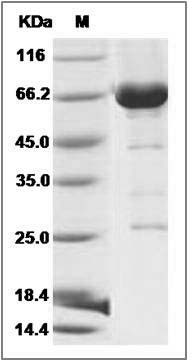-
Product Name
Mouse CDC37 (His & GST Tag) recombinant protein
- Documents
-
Description
CDC37 is a protein that is expressed in proliferative zones during embryonic development and in adult tissues, consistent with a positive role in proliferation and is required for cell division in budding yeast. CDC37 is though to play an important role in the establishment of signaling pathways controlling cell proliferation through targeting intrinsically unstable oncoprotein kinases such as Cdk-4, Raf-1, and src to the molecular chaperone Hsp90. Decreased Hsp90 expression can reduce the levels of microtubule-associated protein tau, whose overexpression may induce many diseases. CDC37 is considered as a co-chaperone that is classified to Hsp90's accessory proteins. It has been reported that suppression of Cdc37 destabilized tau, leading to its clearance, whereas cdc37 overexpression preserved tau.Cdc37 was found to co-localize with tau in neuronal cells and to physically interact with tau from human brain. Moreover, Cdc37 levels significantly increased with age.
-
Protein name
Hsp90 co-chaperone Cdc37
-
Protein short names
P50; P50CDC37; CDC37
-
Uniprot ID
Q61081
-
Gene Name
Cdc37
-
Source/Expression Host
Baculovirus-Insect Cells
-
Expression Plasmid/cDNA
A DNA sequence encoding the mouse CDC37 (Q61081) (Met1-Ala379) was expressed with the N-terminal polyhistidine-tagged GST tag at the N-terminus.
-
Protein Species
Mouse
-
Molecular weight
The recombinant mouse CDC37/GST chimera consists of 616 amino acids and has a calculated molecular mass of 72.4 kDa. The recombinant protein migrates as an approximately 66 kDa band in SDS-PAGE under reducing conditions.
-
Purity
> 85 % as determined by SDS-PAGE
-
Validations

Mouse CDC37 / CDC37A Protein (His & GST Tag) SDS-PAGE
Related Products / Services
Please note: All products are "FOR RESEARCH USE ONLY AND ARE NOT INTENDED FOR DIAGNOSTIC OR THERAPEUTIC USE"
